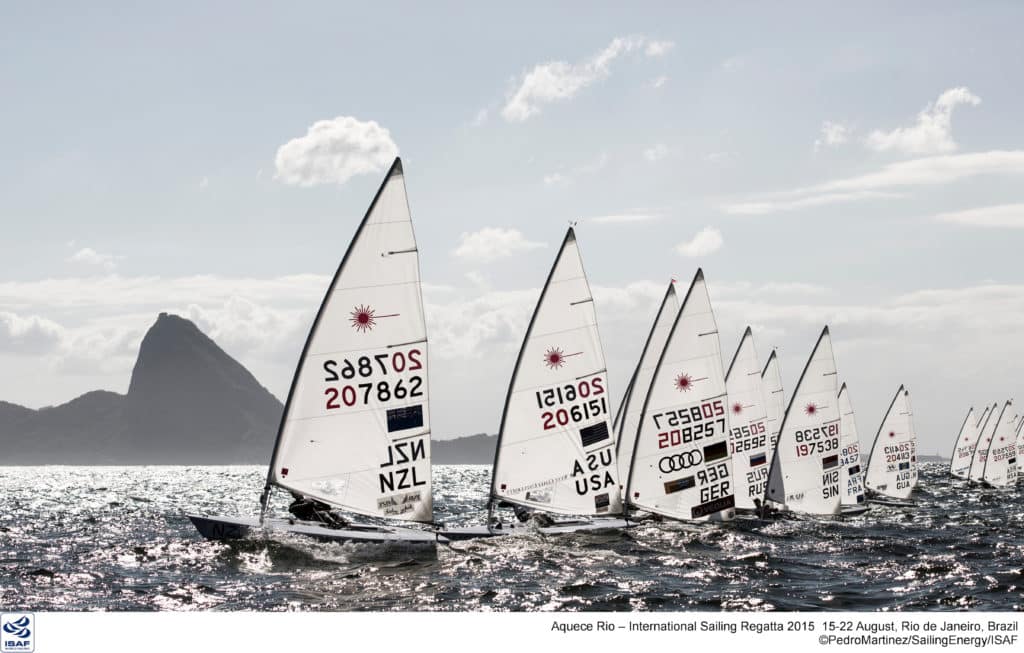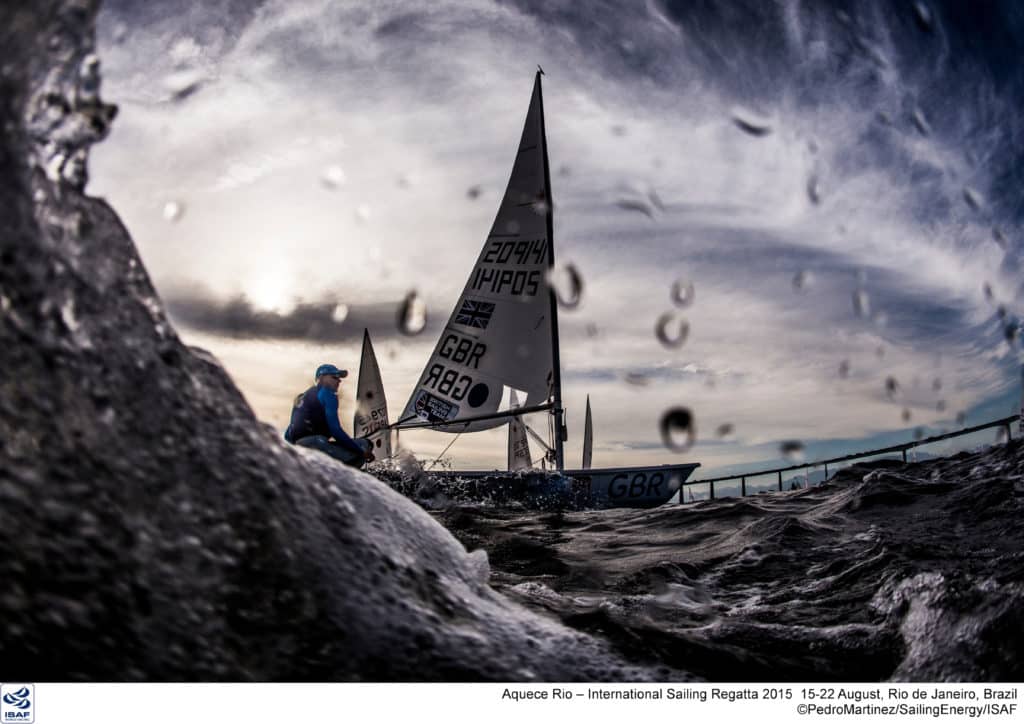
Laser sailing will commence at 13:00 local time on Monday 8 August at the Rio 2016 Olympic Games but what’s the history of the one-person dinghy, where does its roots lie? Well we’ve done all the hard work to provide you with the answers
Previous Olympic Medallists
The first ever Olympic medal in the Laser was won by Brazil’s Robert Scheidt at the Atlanta 1996 Games after a dramatic start line duel with British rival Ben Ainslie. Sydney 2000 saw Ainslie’s revenge, as the Brit match raced the Brazilian for the Gold. Following Ainslie’s switch to the Finn for the Athens 2004 quadrennial Robert Scheidt dominated the class and ultimately made a triumphant return to the top of the podium – his second Olympic Gold medal. Scheidt then switched classes to the Star, leaving another Brit, Paul Goodison, to take Gold at Beijing 2008. London 2012 saw a long-awaited gold for Australia, after years of strong Australian performances Tom Slingsby was finally able to capture the top step for the boxing kangaroos.
Recent World Champions
The Rio 2016 quadrennial kicked off in Oman where Robert Scheidt (BRA) announced his return to the Laser in style by taking his ninth Laser World Championship title. Nicholas Heiner (NED) won in 2014 but the Rio 2016 quad was really dominated by Nick Thompson (GBR) who took third place in 2014 and followed it with back to back World Champion titles in 2015 and 2016.
Life as an Olympic Event
The Laser never fails to deliver drama to proceedings. Five Olympic sailing competitions have seen it all; fierce rivalries, winner-takes-all match racing, surprise upsets, Olympic firsts and of course some of the closest racing on the Olympic sailing program.
The Laser was introduced to the Games as an open class for the 1996 Quadrennial. The simple single-person dinghy already had a cult following of thousands all over the world and inclusion was almost viewed as a forgone conclusion. In 2004 the Laser was changed to from open to men’s lightweight equipment following the inclusion of the Laser Radial as women’s single person dinghy for the 2008 cycle.
The Laser’s low cost means it has the widest pool of nations competing of any Olympic Sailing Class and it’s not unusual to see sailors from nations that aren’t traditionally viewed as big sailing nations on the podium.
What’s it like to sail?
Deceptively simple. The Laser is known as a boat that’s easy to sail badly. Laser sailing and racing presents a unique set of physical and skill based challenges. At the top level it’s a physical class, requiring a very high level of core fitness in order to endure the hiking and body-torque techniques essential to get the boat moving fast.

Short History of the Class and Key specs
The Laser is a 4.19m long, 56.7 kg hiking dinghy with a single 7.06 m2 sail. While not the most high performance class at the Games the Laser probably has the most enthusiastic following.
The Laser’s story began with a phone call between Canadians Bruce Kirby and Ian Bruce. A marketing offshoot of Canada’s Hudson Bay Company had asked Bruce to come up with proposals for a line of outdoor sporting equipment, among them was a boat small enough to be carried on a roof rack of a typical car. As they talked Kirby sketched what would be known as “the million dollar doodle”. The now famous sail was the brainchild Hans Fogh who originally designed it without sight of the rest of the boat. Fogh would go on to tweak his design before finally settling on the rig that we know today.
The sailboat idea was ultimately dropped and the drawing remained in Bruce’s drawer for several months until One Design and Offshore Yachtsman magazine held a regatta for boats under $1000 which Kirby and Bruce saw as the perfect opportunity to launch their little dinghy. With some overnight modifications the prototype that would become the Laser won its class.
After more tweaking the first official Laser was officially unveiled at the New York Boat Show in 1971. The class took off immediately. The first world championship was held in three years later in Bermuda. Entrants came from 24 countries, and first place was won by Peter Commette (USA). The Laser was included in the Olympic roster for the first time for Atlanta 1996 quadrennial and has remained an Olympic Class ever since.
Today more Lasers have been sold than any other type of boat – well over two hundred thousand of them! The simplicity and low cost of the design means Lasers can be found everywhere from the Olympic Games to the beach in front of your hotel on holiday. The biggest attraction of the Laser dinghy is that it is protected by strict one-design class rules, which means each Laser is built to the same specifications and modifications to boats are strictly prohibited. This means every boat is virtually identical which leaves it down to the skill of the sailor to win the race.
Famous Faces
Arguably the greatest champion of the Laser Class is Robert Scheidt from Brazil with two gold and one silver Olympic medals and nine Laser World Champion titles. Only two other sailors can claim more than two Laser World Champion titles; Tom Slingsby (AUS) has five and fellow countryman Glenn Bourke, three. Scheidt’s fierce rivalry with Sir Ben Ainslie (GBR) is the stuff of legend. The Brazilian master will be aiming for his third medal on home waters in Rio when the games kicks off in just a few days’ time.
On the Rio start line, Scheidt will be joined by a colourful cast of talented athletes, vying for their place on the podium. Pavlos Kontides (CYP) – whose silver medal in London was Cyprus’s first ever – will be looking to go one better. Philipp Buhl (GER) and Ton?i Stipanovi? (CRO) who are never far from the podium will both be looking to add Olympic medallist to their impressive sailing CVs.
The Laser has also been home to big names in the sailing world like Ed Baird (USA), Nik Burfoot (NZL), Gustavo Lima (POR), Michael Blackburn (AUS), Mark Mendelblatt (USA) and Vasilij ?bogar (SLO).
Did you know…
The Laser was originally named the “Weekender” with the Prototype sail branded with the letters TGIF for “Thank God it’s Friday”. It was renamed Laser following a suggestion by student Doug Balfour who pointed out that the name ‘Laser’ was modern, recognizable and truly international and that the symmetrical Laser beam logo would only have to go on one side of the sail. The rest is history!









